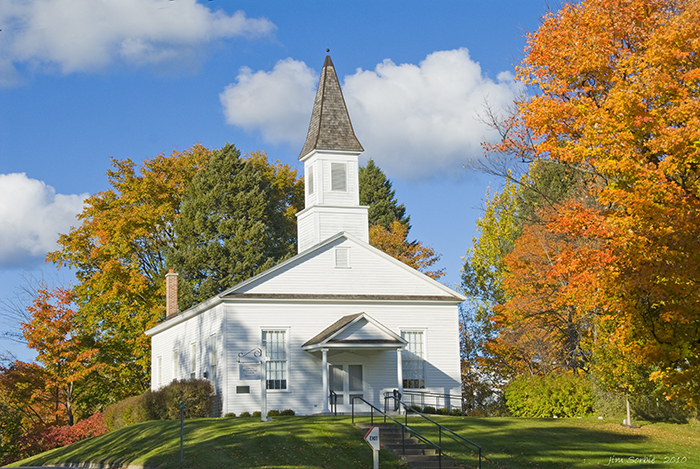
Omena Presbyterian Church. Image: Wikimedia Commons
By Eric Freedman
Capital News Service
The Leelanau Peninsula hamlet of Omena, Michigan, – with its remnants of a once-popular summer resort, an 1853 church and the pilings of long-gone docks that once welcomed boatloads of tourists – has earned a spot on the National Register of Historic Places.
Designation of the Omena Historic District reflects its legacy as a resort area, a mission to convert Native Americans to Christianity, a productive agricultural area and a Lake Michigan harbor.
“Most of Omena’s buildings are still in use as originally intended, some still in the same family ownership since the 1800s,” according to the nomination documents. “Omena’s changes have been adaptations built upon its existing structure, and the village has not suffered the eradication, wasteful misuse of resources and reconstruction that is so common in this country.”
Marsha Buehler, an Omena Historical Society board member who spearheaded the nomination, said, “We’ve got this little gem, a cluster of buildings on a bend in the road. It looks very much like it did at the turn of the 20th century.”
The National Register is “the official list of the nation’s historic places worthy of preservation,” says the National Park Service, which administers the program. The federal program helps “coordinate and support public and private efforts to identify, evaluate and protect America’s historic and archeological resources.”
The Omena Historic District is the 23rd Leelanau County site on the National Register. Among the others are four more historic districts – South Manitou Island Lighthouse Complex and Life-Saving Station, Leland, Port Oneida and Glen Haven – as well as the Grand Traverse Light Station, North Manitou Island Life-Saving Station and several farms, schools and churches.
Thirteen sites in neighboring Grand Traverse County are on the National Register. There are 1,919 places on the register across the state, according to the National Park Service.
The new historic district faces Omena Bay, a “deep water indentation” on Grand Traverse Bay.
The settlement dates to 1851 when a Presbyterian minister, Peter Dougherty, arrived from Mission Peninsula across the West Arm of Grand Traverse Bay. He taught English, manual training, farming and academic subjects to Native American children.
Landmarks in the historic district include five remaining buildings from Sunset Lodge, which started as a retirement home, expanded to add cottages and a social hall, and was a popular vacation resort until World War II.
As decades passed, the lodge’s owners appealed to the “changing tastes of resorters, who first arrived solely by steamer, then by train and steamer, and then motored in for shorter and shorter periods by automobile,” the nomination documents say. It currently operates as a bed-&-breakfast.
Mary Ziegeler, who bought Sunset Lodge in 2014 with her husband, said B&B guests “always have questions about how it got started, its history.” It’s the only survivor among what once had been eight resorts in Omena.
Now with the National Register listing, Ziegeler said the lodge wants to place a historic marker there.
What is now Omena Presbyterian Church opened in 1858 as the Grove Hill New Mission Church and conducted worship services in the Ottawa and English languages. Its bell was made from English copper pennies donated by Chippewa, according to church history.
A cemetery behind the church holds the graves of 290 Native Americans and American settlers, according to a stone monument there. One of them is Chief Aghosa, a Chippewa chief who converted to Christianity.
Adjacent to the township beach and park are what’s left of wooden pilings from the Anderson Dock. They symbolize “what was once a safe landing for steamships, the predominant way of travel and commerce trade in the late 19th century and early 20th century,” the nomination documents say.
Also in the historic district stands a Victorian farmhouse on land formerly owned by Col. George Armstrong Custer, who died at the Battle of Little Bighorn in 1876, the same year the house was built.
Jesuits later used part of the farmhouse as a worship area. The building was later moved and now serves as the Omena Historical Society’s Putnam-Cloud Tower House Museum.
Historic preservation students at Eastern Michigan University helped with research and the designation process. The State Historic Preservation Review Board recommended the designation to the National Park Service.
Listing on the National Register provides opportunities for preservation incentives including federal grants for planning and rehabilitation and federal investment tax credits.
“For a community like Omena, the historic district designation will allow people to apply for incentives” such as tax credits, said Laura Ashlee, a historian at the State Historic Preservation Office.
